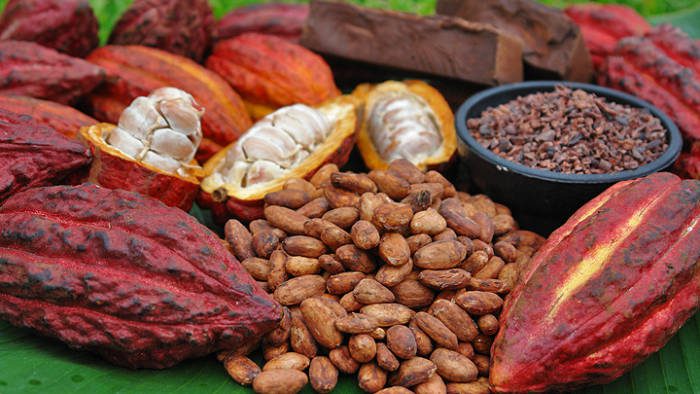The St. Vincent Cocoa Company says it would like to access state lands to plant more cocoa as the St. Vincent Chocolate Company moves into the production of chocolate bars locally.
Speaking at an event in late December at which the chocolate bars were launched, Harry Marriott, chair of the St. Vincent Chocolate Company said that as he understands it, barely 20 per cent of arable lands in St. Vincent are under cultivation.
“But I understand the issues. They are sensitive. But there is a big untapped potential out there,” he said.
Marriott said the Cocoa Company is buying its own lands and planted 100 acres of cocoa in 2015 and will be buying land for the foreseeable future to boost cocoa production.
“There are many thousands of acres of Crown land lying completely fallow. So we have made a formal request to the Government to fulfil its promise made when we took over the company to lease us land. Hopefully, Cabinet approval will be forthcoming soon — I am very confident.”
The St. Vincent Cocoa Company took over from Amajaro, when the latter pulled out of the country in late 2014, after about three years because significantly fewer acres of cocoa had been planted than anticipated.
Marriott told reporters that his company’s investment in increased acreage of cocoa “will provide a welcome boost to the industry as well as well as provide jobs for many people where they desperately need it in the rural communities, the poorest people in the country. That’s what we need to do.
“I can assure you that stories of our demise — past, present and future — are grossly exaggerated.”
Speaking to reporters at the same event, Minister of Agriculture, Saboto Caesar said that the Cocoa Company has invested significant sums of money in rehabilitating some 600 acres of cocoa plantations.
He noted that the company intends to purchase land from the private sector and noted the request to access state lands.
“And it is something that has to be decided mainly by the Ministry of Lands and Surveys. So the due diligence will have to be done, environmental assessments will have to be done on the parcels of lands and we will be in contact with them in due course,” Caesar said.
He, however, contended that more than 20 per cent of the arable lands in the country are under cultivation.
“I am not going to go with that 20 per cent,” Caesar said, noting that SVG has 18,000 acres of land available for farming.
“We have far more than 20 per cent of our arable lands under cultivation. It is more in the tune of 60 per cent. We have in the aftermath in the heyday of the bananas – 1992 — stopped farming very high and close to the watershed areas. We have come down from the 1,000 contour and we are farming now in more areas that are low-lying. With more cocoa production, we intend to move closer up to those areas that were once farmed with bananas,” Caesar said.
He told reporters that the government intends to begin a programme to cultivate 3,000 acres of bananas and has signed an agreement with an investor from the UK to establish some 2,000 acres of coffee in SVG.
“So, it is not only cocoa, we are also looking at coffee as a very important crop going forward…
“I am certain that when we have the opening of the Argyle International Airport, we are going to see the sovereign shops stock locally made chocolate bars.
“For many years, we have produced chocolate sticks and we have exported it, significantly to persons in the diaspora, and I am certain that persons in the diaspora are happy and proud to know that today they can purchase local chocolate bars,” Caesar said.







Give them the Crown land they say they need, with the necessary and verifiable environmental regulations in place and enforced. Also help them with duty free allowances and other concessions. But don’t give the company any money or sign any loan guarantees for them, please!
As for the claim that, “… the St. Vincent Chocolate Company [has] move[d] into the production of chocolate bars locally,” I see no evidence of this claim just the production of a few bars to demonstrate how good the quality of our cocoa is. This is because the mass production of chocolate bars at the place that cocao trees are planted, is not how the industry was established or currently operates: the production of cocoa and the production of chocolate products are far different processes (see below) that usually occur thousands of miles from each other.
Also, Mr. Caesar’s claim that, “For many years, we have produced chocolate sticks and we have exported it, significantly to persons in the diaspora” is pure hyperbole. A few unprocessed cocoa sticks taken in a suitcase overseas to remind our humble folk who have migrated of the ugly ass gritty tea they drank while growing up (alongside the middle and upper classes who long made their tea from Fry’s cocoa refined in and imported from England), does not meet my definition of “significantly.”
Please see below the steps for making cocoa powder suitable more mass consumption. The two most important steps in producing attractive cocoa powder for cocoa tea (often called “hot chocolate”) are alkalization (Step 4) and removal of the cocoa butter (Step 7). Neither step is taken to produce our primitive cocoa tea which is characterized by lots of undissolved particles of liquid butter and solid cocoa particles. Yuck.
“Summary of the process of transforming cocoa beans into chocolate (http://www.icco.org/about-cocoa/processing-cocoa.html):
Step 1. The cocoa beans are cleaned to remove all extraneous material.
Step 2. To bring out the chocolate flavour and colour, the beans are roasted. The temperature, time and degree of moisture involved in roasting depend on the type of beans used and the sort of chocolate or product required from the process.
Step 3. A winnowing machine is used to remove the shells from the beans to leave just the cocoa nibs.
Step 4. The cocoa nibs undergo alkalisation, usually with potassium carbonate, to develop the flavour and colour.
Step 5. The nibs are then milled to create cocoa liquor (cocoa particles suspended in cocoa butter). The temperature and degree of milling varies according to the type of nib used and the product required.
Step 6. Manufacturers generally use more than one type of bean in their products and therefore the different beans have to be blended together to the required formula.
Step 7. The cocoa liquor is pressed to extract the cocoa butter, leaving a solid mass called cocoa presscake. The amount of butter extracted from the liquor is controlled by the manufacturer to produce presscake with different proportions of fat.
Step 8. The processing now takes two different directions. The cocoa butter is used in the manufacture of chocolate. The cocoa presscake is broken into small pieces to form kibbled presscake, which is then pulverised to form cocoa powder.
Step 9. Cocoa liquor is used to produce chocolate through the addition of cocoa butter. Other ingredients such as sugar, milk, emulsifying agents and cocoa butter equivalents are also added and mixed. The proportions of the different ingredients depend on the type of chocolate being made.
Step 10. The mixture then undergoes a refining process by travelling through a series of rollers until a smooth paste is formed. Refining improves the texture of the chocolate.
Step 11. The next process, conching, further develops flavour and texture. Conching is a kneading or smoothing process. The speed, duration and temperature of the kneading affect the flavour. An alternative to conching is an emulsifying process using a machine that works like an egg beater.
Step 12. The mixture is then tempered or passed through a heating, cooling and reheating process. This prevents discolouration and fat bloom in the product by preventing certain crystalline formations of cocoa butter developing.
Step 13. The mixture is then put into moulds or used for enrobing fillings and cooled in a cooling chamber.
Step 14. The chocolate is then packaged for distribution to retail outlets.”
My addition:
Step 15. The chocolate bars and other confections are then shipped — sent by boat, not plane — back to St. Vincent where the cocoa plants were grown.
Also, in many countries, Step 1 is followed by drying in the sun, followed by the bagging and shipping of the beans overseas; elsewhere, overseas shipment — note: in ships, not planes — takes place after Step 2 or Step 3.
We should not let our politicians continually pull the wool over our eyes with their dumb-ass assertions and false promises!